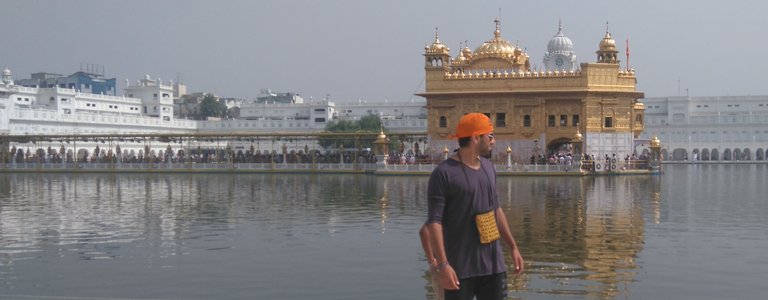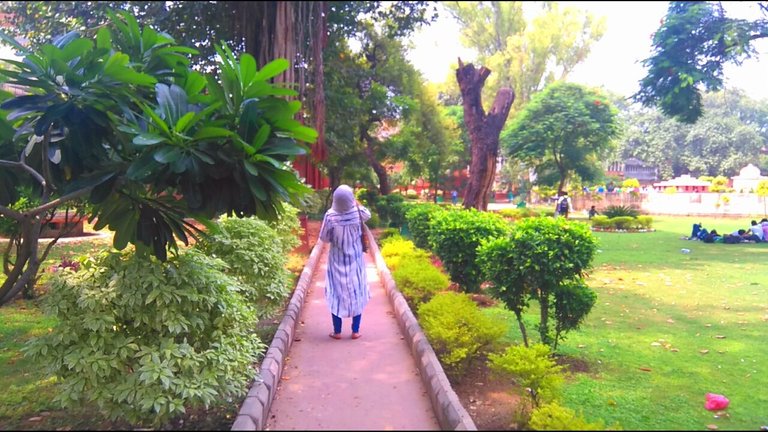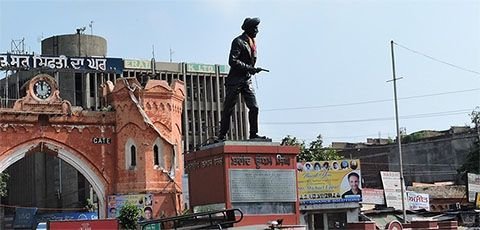India’s story is as vast as her size, and as rich as her people’s many cultures and languages. Perhaps this abundance is the reason why my mother has such a keen interest in the country’s history. Since she moved back to India in 2013, I have visited her almost every year.
In summer 2015, we took a two-week trip around the state of Punjab, which lies in the northwestern part of India. We visited the city of Amritsar where the Sri Harmandir Sahib (“the abode of God”), also known as the Golden Temple, lies. It is the holiest site of the Sikh religion.

The Temple itself is surrounded by a man-made pool,
around which pilgrims walk before entering the Temple proper.
After visiting the temple, we headed towards Jallianwala Bagh, a public garden which is located within walking distance. My mother explained:
"Jallianwala Bagh is a place of significant history in the story of India. Many say that what happened here was the straw that broke the camel’s back in removing the British from power."
When we entered I couldn’t help but notice the stark contrast between the garden in front of us, and the street just a few steps behind. Gone were the crowds, noise, and smell of gasoline from the tuk-tuks. Couples sat in the grass chatting, their only concern each other, others strolled along the garden paths, birds were chirping, and squirrels scampered around looking for bounty. A serene setting.

My mother stops to drink some water.
After some time, we reached the middle of the garden, where a small pyre sat on stone platform. A plaque was attached to the stone, with words written in Hindi. My mother translated:
“The garden serves as a memorial to commemorate the victims of the ‘Jallianwala Bagh Massacre’ on 13 April 1919…While the official death toll is 379 casualties, the real figure is likely many times higher. Around the memorial, bullet holes and rubble are maintained as a grim reminder of what occurred nearly a century ago.”
She explained as we continued walking, occasionally stopping to point towards the corresponding areas.
"The evening before the massacre, several academics at the Hindu College in Amritsar organized a meeting to be held in Jallianwala Bagh the next day, in protest of a curfew issued by the British. The curfew had been implemented in response to an attack on British-Indians by some locals.
On the day of the attack, around 20,000 people had gathered in the park by midday; a mixture of pilgrims (who had been worshipping earlier that day at the Temple), merchants attending the annual cattle fair, locals, and those invited to the meeting. By 16:30 the shooting began.
The operation was led was led by General Dyer (an ominous name if there ever was one), who placed his men in position to cover all five of the exits. Without warning he gave the signal to begin shooting. His orders had been two-fold: aim where the crowd is most dense, and shoot the exits when people try to escape. With no escape route, many people jumped into the empty wells to try and save themselves. It is estimated that 120 dead bodies were retrieved from these wells. When asked why he gave no warning before firing, Dyer explained their mission was ‘not to disperse the meeting but to punish the Indians for disobedience.’
The Governor of Punjab Michael O’Dwyer, found nothing wrong with the actions of his subordinate. In Britain opinion was divided as to whether this massacre had been senseless or a necessary quelling of a rebellion. In mid-1920, a commission found Dyer to have overstepped his bounds in handling the situation, stating “[General Dyer] thought he had crushed the rebellion…[but] there was no rebellion which required to be crushed”. During the hearing, public opinion in Britain shifted against Dyer as details of the massacre and his defence of his actions came to light. He was eventually dismissed from the army, but received no punishment beyond that. He died in 1927, and on his deathbed addressed the issue: ‘I only want to die and know from my Maker whether I did right or wrong.’"
We continued strolling around the garden in silence, observing the birds in the trees and the people sitting in the grass quietly chatting. We reached the exit, and found a taxi close to the park. 5 minutes into the drive we were entering a roundabout, in the center of which a statue stood. I don’t think it would have caught my eye but for it depicting a man in motion, pointing a pistol at his hip as if targeting something.
 “Who is that?” I asked my mother.
“Who is that?” I asked my mother.
“I don’t know.” She said, the statue had caught her eye too. She turned to the driver and asked in Hindi, “What is your name, sir?”
“Harminder, ma’am.” The driver replied.
“Mr. Harminder, do you know of whom this statue is?” She asked.
“It is a statue of Udham Singh, a great hero in India…At 19 years old, he was amongst the 20,000 people assembled at Jallianwala Bagh. He and some friends were serving water to the assembled crowd. In the end he survived the attack, though it deeply scarred him.
Later in life he joined a revolutionary group looking to overthrow British rule in India. In 1927, at the age of 29, he was arrested and senteced to five years in prison for possession of firearms. When he was released he travelled to Germany, and eventually made his way to London in 1934.
On 13 March 1940, there was a talk scheduled at Caxton Hall where the former Governer of Punjab Michael O’Dwyer, was scheduled to talk. After he had taken to the podium, Udham Singh walked towards the stage, drew his pistol, and opened fire. O’Dwyer was hit twice, and died instantly. Udham Singh did not try to escape. He was convicted in an open-and-shut case, and when asked his motive after he had been sentenced to death for murder, replied: 'It was my duty. What greater honour could be bestowed on me than death for the sake of my motherland?'
On 31 July 1940, Singh was hanged. While public opinion in India was largely in favor of Singh’s actions assassination, they were not without controversy on the political level. Gandhi famously referred to the assassination as “an act of insanity”. Nevertheless, every year on 31 July marches are held, and flowers are laid on and around the statues of Udham Singh in his honor.”
I looked out the window at the passing road. In every village, every city, and every corner of every street there is a story that spans millennia…India, a land with history as rich and diverse as its people.

Hello! Thank you for having read the whole story. If you enjoyed this blog post, please give me @alihasnain3k a follow! Any feedback is appreciated, thank you :)






The first photo is mighty cool^^
Thanks buddy :)
Exquisite